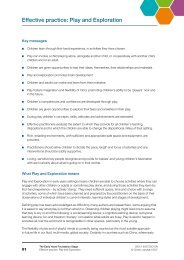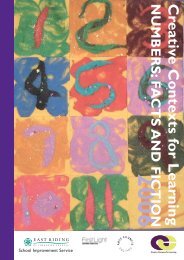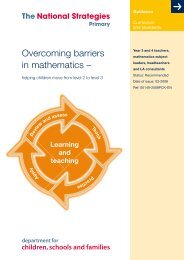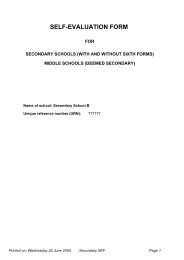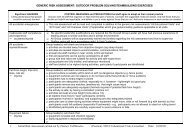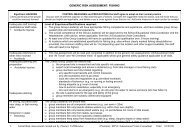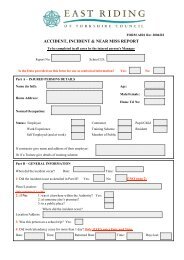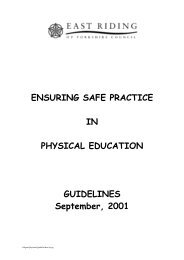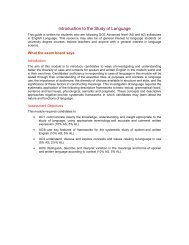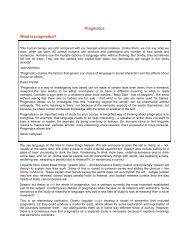Listening to Young Children - Northamptonshire County Council
Listening to Young Children - Northamptonshire County Council
Listening to Young Children - Northamptonshire County Council
Create successful ePaper yourself
Turn your PDF publications into a flip-book with our unique Google optimized e-Paper software.
We videoed the activity and later used it <strong>to</strong> show the<br />
parents about how their children were using their<br />
imagination and exploration of the objects <strong>to</strong> convey their<br />
feelings in the painting activity.<br />
Many parents/carers were surprised at how much their<br />
children expressed themselves at using other available<br />
resources so confidently and imaginatively. Some<br />
parents/carers said they would feel more confident <strong>to</strong> try<br />
this activity at home.<br />
Busy Bees Preschool/<br />
Playgroup<br />
Ann Byford and Hilary Hamil<strong>to</strong>n<br />
Specific Aims:<br />
Our listening <strong>to</strong> young children project had several aims<br />
including <strong>to</strong> help children make choices, <strong>to</strong> help<br />
communication with children and <strong>to</strong> settle in new children.<br />
Activity:<br />
To produce a pho<strong>to</strong> Album of all the <strong>to</strong>ys in the setting<br />
and label it as a resource book. We believe that<br />
producing a pho<strong>to</strong>graphic book of all the <strong>to</strong>ys and<br />
activities that we have available would help children<br />
further <strong>to</strong> make choices and voice what they would like <strong>to</strong><br />
do. The children helped us take pho<strong>to</strong>graphs of the <strong>to</strong>ys<br />
and then we had two copies produced. We used the<br />
‘Likes and Dislikes’ booklet from the Coram Resource<br />
pack <strong>to</strong> guide us.<br />
The first set of pho<strong>to</strong>graphs were laminated and<br />
separated <strong>to</strong> the different areas of development and filed<br />
in an A4 folder. This folder was then placed for easy<br />
access <strong>to</strong> children and parents/carers.<br />
The folder is used for many different purposes:<br />
• Staff used the folder for planning, <strong>to</strong> identify activities<br />
<strong>to</strong> meet the developmental needs of the children in<br />
their care.<br />
• The children made their own decisions about what they<br />
would like <strong>to</strong> play with.<br />
• It helped settle newly arrived children by giving them<br />
the folder <strong>to</strong> look at and decide what they wanted <strong>to</strong> do<br />
- a new setting with lots of children and <strong>to</strong>ys as we<br />
know can be overwhelming. One child who was new <strong>to</strong><br />
the setting always asked for the folder <strong>to</strong> choose what<br />
she wanted <strong>to</strong> play with. She became more settled as a<br />
result and started <strong>to</strong> use her voice more. We believe it<br />
was the resource folder that helped her <strong>to</strong> do this.<br />
• It also helped children <strong>to</strong> choose what they wanted <strong>to</strong><br />
play with but who were less verbal.<br />
• A potential parent/carer came <strong>to</strong> visit the setting<br />
<strong>to</strong>wards the end of the day after everything was<br />
packed away. We were able <strong>to</strong> use the folder <strong>to</strong> share<br />
what resources the setting had with potential new<br />
parents/cares when they came <strong>to</strong> look around. It<br />
helped <strong>to</strong> explain how children are encouraged <strong>to</strong><br />
make choices and <strong>to</strong> be independent.<br />
The second set of pho<strong>to</strong>graphs were used <strong>to</strong> create an<br />
identical folder <strong>to</strong> help us review activities for the day.<br />
Using a large plastic clear pocket sheet with lots of<br />
individual pockets, we placed the activities that children<br />
played with during the day in them. We laminated happy<br />
and sad faces and the children, parents/carer and staff<br />
were encouraged <strong>to</strong> put a smiley or a sad face in each<br />
activity pocket. The children found this an exciting new<br />
game. However, once the initial excitement had worn off,<br />
the children used the happy and sad faces <strong>to</strong> describe<br />
how they felt about the activity they participated in, and<br />
key workers came alongside <strong>to</strong> hear what they had <strong>to</strong><br />
say. We have found it <strong>to</strong> be a great reflection <strong>to</strong>ol which<br />
will inform our future planning.<br />
Tudor Manor Day Nursery,<br />
Project: Feeling S<strong>to</strong>ne<br />
Vikki Cox and Gemma Humphreys<br />
Specific Aims:<br />
To involve the children in making choices around the<br />
nursery in everyday activities including outside play area.<br />
To enable staff <strong>to</strong> listen <strong>to</strong> young children <strong>to</strong> talk about<br />
their feelings.<br />
Activity:<br />
We wanted the young children <strong>to</strong> share responsibility in<br />
the planning of our project; choosing <strong>to</strong>ys and other<br />
activities <strong>to</strong> play with. We used the Feelings booklet from<br />
the Coram resource pack <strong>to</strong> help give us some ideas.<br />
In our nursery each room has designated areas for the 6<br />
areas of learning; Maths; Communication, Language and<br />
Literacy; Personal, Social and Emotional development;<br />
Knowledge and Understanding of the World; Physical<br />
development; Creative development. We decided <strong>to</strong><br />
concentrate on activities addressing 2 of the 6 areas of<br />
learning as we foresaw difficulties in managing all 6 areas<br />
due <strong>to</strong> lack of s<strong>to</strong>rage. During our group times (with<br />
children aged 3-5) we explained <strong>to</strong> the children what we<br />
were going <strong>to</strong> do and included them in all the planning.<br />
We <strong>to</strong>ok pho<strong>to</strong>graphs of the <strong>to</strong>ys and activities available<br />
in the 2 areas of learning and developed an activity wall<br />
and labelled it ‘what we have chosen <strong>to</strong> have out’.<br />
19



